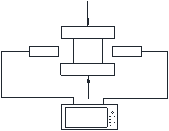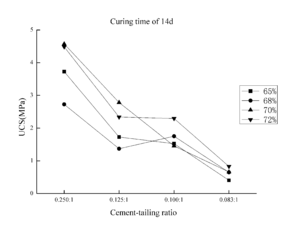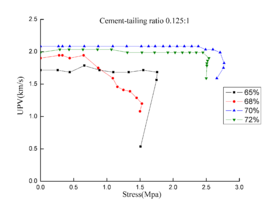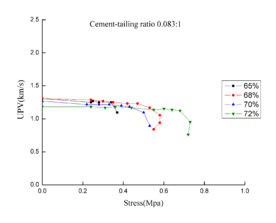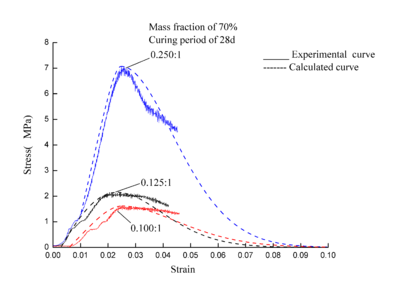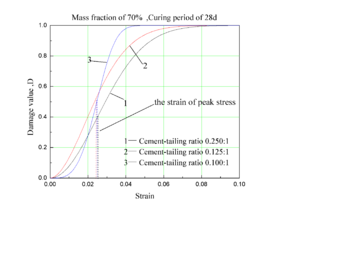| Line 6: | Line 6: | ||
==Analysis of damage failure in uniaxial compressive of cemented paste backfill by ultrasonic pulse velocity test== | ==Analysis of damage failure in uniaxial compressive of cemented paste backfill by ultrasonic pulse velocity test== | ||
| − | + | Bingwen Wang<sup>1</sup> Lin Li<sup>1 </sup> Yao Yu<sup>1</sup> Benyong Huo<sup>1</sup> Jian Liu<sup>1</sup> Jie Liu<sup>2</sup> | |
<span style="text-align: center; font-size: 75%;">1</span> <span style="text-align: center; font-size: 75%;">School of Energy and Mining Engineering, China University of Mining & Technology (Beijing), Beijing 100083, China</span> | <span style="text-align: center; font-size: 75%;">1</span> <span style="text-align: center; font-size: 75%;">School of Energy and Mining Engineering, China University of Mining & Technology (Beijing), Beijing 100083, China</span> | ||
| Line 113: | Line 113: | ||
Mixing unclassified tailings and cementitious materials, a series of samples (mass fraction of 65%,68%,70% and 72%) were made at cement-tailing ratios of 0.250:1, 0.125:1, 0.100:1 and 0.083:1 respectively. The required amount of unclassified-tailings, cementitious materials and water | Mixing unclassified tailings and cementitious materials, a series of samples (mass fraction of 65%,68%,70% and 72%) were made at cement-tailing ratios of 0.250:1, 0.125:1, 0.100:1 and 0.083:1 respectively. The required amount of unclassified-tailings, cementitious materials and water | ||
| − | are mixed and homogenized in a mixer until obtaining the desired mixtures. Afterwards, the produced cemented unclassified tailings backfill mixtures are poured into curing cubes of 7.07 <math display="inline">\times</math> 7.07 <math display="inline">\times</math> 7.07cm in length <math display="inline">\times</math> width <math display="inline">\times</math> height to form cubics CPB samples. Then, these samples are cured in YH-40B standard curing chamber (Fig. 1) at temperature of 20 <math display="inline">\pm</math> | + | are mixed and homogenized in a mixer until obtaining the desired mixtures. Afterwards, the produced cemented unclassified tailings backfill mixtures are poured into curing cubes of 7.07 <math display="inline">\times</math> 7.07 <math display="inline">\times</math> 7.07cm in length <math display="inline">\times</math> width <math display="inline">\times</math> height to form cubics CPB samples. Then, these samples are cured in YH-40B standard curing chamber (Fig. 1) at temperature of 20 <math display="inline">\pm</math> 1 <math display="inline">℃</math> and for period of 7,14 and 28 days. |
===2.3 UCS and UPV tests === | ===2.3 UCS and UPV tests === | ||
| Line 125: | Line 125: | ||
<div class="center" style="width: auto; margin-left: auto; margin-right: auto;"> | <div class="center" style="width: auto; margin-left: auto; margin-right: auto;"> | ||
| − | |||
| − | |||
| − | |||
| − | |||
| − | |||
| − | |||
| − | |||
{| | {| | ||
|- | |- | ||
| − | | [[Image: | + | | [[Image:Review_156654264638-image1.jpeg|192px]] |
| − | | [[Image: | + | | [[Image:Review_156654264638-image2.jpeg|center|264px]] |
|} | |} | ||
</div> | </div> | ||
| + | |||
| + | (a) (b) | ||
<div class="center" style="width: auto; margin-left: auto; margin-right: auto;"> | <div class="center" style="width: auto; margin-left: auto; margin-right: auto;"> | ||
| + | [[Image:Review_156654264638-image3.jpeg|282px]] </div> | ||
| − | + | <div class="center" style="width: auto; margin-left: auto; margin-right: auto;"> | |
| − | + | (c)</div> | |
| − | + | ||
| − | + | ||
| − | + | ||
| − | + | ||
| − | </div> | + | |
Fig. 1. Preparation and testing of CPB samples: (a)mixing; (b)CPB samples; (c)UPV and UCS tests. | Fig. 1. Preparation and testing of CPB samples: (a)mixing; (b)CPB samples; (c)UPV and UCS tests. | ||
| Line 156: | Line 147: | ||
{| | {| | ||
|- | |- | ||
| − | | [[Image: | + | | [[Image:Review_156654264638-picture- 1.svg|center|52px]] |
| − | | [[Image: | + | | [[Image:Review_156654264638-picture- 2.svg|center|54px]] |
|} | |} | ||
{| | {| | ||
|- | |- | ||
| − | | [[Image: | + | | [[Image:Review_156654264638-picture- 3.svg|center|51px]] |
| − | | [[Image: | + | | [[Image:Review_156654264638-picture- 4.svg|center|52px]] |
|} | |} | ||
{| | {| | ||
|- | |- | ||
| − | | [[Image: | + | | [[Image:Review_156654264638-picture- 5.svg|center|99px]] |
| − | | [[Image: | + | | [[Image:Review_156654264638-picture- 6.svg|center|99px]] |
|} | |} | ||
{| | {| | ||
|- | |- | ||
| − | | [[Image: | + | | [[Image:Review_156654264638-picture- 7.svg|center|99px]] |
| − | | [[Image: | + | | [[Image:Review_156654264638-picture- 8.svg|center|139px]] |
|} | |} | ||
| − | [[Image: | + | [[Image:Review_156654264638-image4.png|438px]] </div> |
<div class="center" style="width: auto; margin-left: auto; margin-right: auto;"> | <div class="center" style="width: auto; margin-left: auto; margin-right: auto;"> | ||
| Line 193: | Line 184: | ||
{| | {| | ||
|- | |- | ||
| − | | [[Image: | + | | [[Image:Review_156654264638-image5-c.png|282px]] |
| − | | [[Image: | + | | [[Image:Review_156654264638-image6-c.png|center|294px]] |
|} | |} | ||
| Line 201: | Line 192: | ||
<div class="center" style="width: auto; margin-left: auto; margin-right: auto;"> | <div class="center" style="width: auto; margin-left: auto; margin-right: auto;"> | ||
| − | [[Image: | + | [[Image:Review_156654264638-image7-c.png|276px]] </div> |
<div class="center" style="width: auto; margin-left: auto; margin-right: auto;"> | <div class="center" style="width: auto; margin-left: auto; margin-right: auto;"> | ||
| Line 209: | Line 200: | ||
<div class="center" style="width: auto; margin-left: auto; margin-right: auto;"> | <div class="center" style="width: auto; margin-left: auto; margin-right: auto;"> | ||
| − | + | ||
| − | + | ||
{| | {| | ||
|- | |- | ||
| − | | [[Image: | + | | [[Image:Review_156654264638-image8.png|222px]] |
| − | | [[Image: | + | | [[Image:Review_156654264638-image9.png|center|228px]] |
|} | |} | ||
| + | </div> | ||
| + | :(1) (b) | ||
| − | + | <div class="center" style="width: auto; margin-left: auto; margin-right: auto;"> | |
| − | + | [[Image:Review_156654264638-image10.png|240px]] </div> | |
| − | + | ||
| − | + | <div class="center" style="width: auto; margin-left: auto; margin-right: auto;"> | |
| − | + | (c)</div> | |
| − | + | ||
| − | + | ||
| − | + | ||
| − | + | ||
| − | + | ||
| − | + | ||
| − | </div> | + | |
Fig. 4. SEM images of CPB samples (mass fraction of 70%, cement-tailing ratio of 0.250:1) at different curing time: (a) curing time of 7 days; (b) curing time of 14 days and (c) curing time of 28 days. | Fig. 4. SEM images of CPB samples (mass fraction of 70%, cement-tailing ratio of 0.250:1) at different curing time: (a) curing time of 7 days; (b) curing time of 14 days and (c) curing time of 28 days. | ||
| Line 240: | Line 225: | ||
{| | {| | ||
|- | |- | ||
| − | | [[Image: | + | | [[Image:Review_156654264638-image11-c.png|276px]] |
| − | | [[Image: | + | | [[Image:Review_156654264638-image12-c.png|center|276px]] |
|} | |} | ||
| Line 251: | Line 236: | ||
{| | {| | ||
|- | |- | ||
| − | | [[Image: | + | | [[Image:Review_156654264638-image13-c.png|282px]] |
| − | | [[Image: | + | | [[Image:Review_156654264638-image14-c.png|center|276px]] |
|} | |} | ||
| Line 386: | Line 371: | ||
<div class="center" style="width: auto; margin-left: auto; margin-right: auto;"> | <div class="center" style="width: auto; margin-left: auto; margin-right: auto;"> | ||
| − | [[Image: | + | [[Image:Review_156654264638-image15-c.png|396px]] </div> |
<div class="center" style="width: auto; margin-left: auto; margin-right: auto;"> | <div class="center" style="width: auto; margin-left: auto; margin-right: auto;"> | ||
| Line 429: | Line 414: | ||
<div class="center" style="width: auto; margin-left: auto; margin-right: auto;"> | <div class="center" style="width: auto; margin-left: auto; margin-right: auto;"> | ||
| − | [[Image: | + | [[Image:Review_156654264638-image16-c.png|348px]] </div> |
<div class="center" style="width: auto; margin-left: auto; margin-right: auto;"> | <div class="center" style="width: auto; margin-left: auto; margin-right: auto;"> | ||
| Line 478: | Line 463: | ||
==References== | ==References== | ||
| − | [1] T.Grice, Underground mining with backfill, Australian mining consultants, in the 2nd Annual Summit-Mine Tailing Disposal Systems,Brisbane,Australia | + | [1] T.Grice, Underground mining with backfill, Australian mining consultants, in the 2nd Annual Summit-Mine Tailing Disposal Systems,Brisbane,Australia,pp.24-25,1998. |
| − | [2] M.Fall, J.C.Celestin, M.Pokharel, M.Toure. A contribution to understanding the effects of curing temperature on the mechanical properties of mine cemented tailings backfill | + | <span id='_GoBack'></span>[[#cite-_GoBack|[2]]] M.Fall, J.C.Celestin, M.Pokharel, M.Toure. A contribution to understanding the effects of curing temperature on the mechanical properties of mine cemented tailings backfill. Eng.Geol,114:397-413, 2010. |
| − | [3] Mchaina, D.M.Januszewski, S.Hallam, R.L. Development of an environmental impct and mitigation assessment program for a tailings storage facility stability upgrade. International Journal of Surface Min.Recla Environ, 15 | + | [3] Mchaina, D.M.Januszewski, S.Hallam, R.L. Development of an environmental impct and mitigation assessment program for a tailings storage facility stability upgrade. International Journal of Surface Min.Recla Environ, 15: 123-140, 2001. |
| − | [4] Meggyes, T.Niederlethinger, E.Witt, K.J. Enhancing the safety of tailings management facilities. Soil and Sediment Contamination, 17 | + | [4] Meggyes, T.Niederlethinger, E.Witt, K.J. Enhancing the safety of tailings management facilities. Soil and Sediment Contamination, 17: 323-345, 2008. |
| − | [5] Friedrich, L.Halden, N.M. Determining exposure history of northern pike and walleye to tailings effluence using trace metal uptake in otoliths. Environ Sci Tech,44 | + | [5] Friedrich, L.Halden, N.M. Determining exposure history of northern pike and walleye to tailings effluence using trace metal uptake in otoliths. Environ Sci Tech,44: 1551-1558, 2010. |
| − | [6] Yilmaz E, Benzaazoua M, Belem T. Effect of curing under pressure on compressive strength development of cemented paste backfill. Miner Eng | + | [6] Yilmaz E, Benzaazoua M, Belem T. Effect of curing under pressure on compressive strength development of cemented paste backfill. Miner Eng, 22: 772-785,2009. |
| − | [7] Yilmaz E., Belem T., BenzaazouaM. Effects of curing and stress conditions on hydromechanical, geotechnical and geochemical properties of cemented paste backfill. Eng Geol | + | [7] Yilmaz E., Belem T., BenzaazouaM. Effects of curing and stress conditions on hydromechanical, geotechnical and geochemical properties of cemented paste backfill. Eng Geol, 168: 23-37, 2014. |
| − | [8] Yilmaz E., Belem T., Benzaazoua M. Specimen size effect on strength behavior of cemented paste backfills subjected to different placement conditions. Eng Geol | + | [8] Yilmaz E., Belem T., Benzaazoua M. Specimen size effect on strength behavior of cemented paste backfills subjected to different placement conditions. Eng Geol, 185: 52-62, 2015. |
| − | [9] Yilmaz E, Fall M. Paste tailings management. Canada: Springer International | + | [9] Yilmaz E, Fall M. Paste tailings management. Canada: Springer International, p. 103-110, 2017. |
| − | [10] Benzaazoua M, Fall M, Belem T. A contribution to understanding the hardening process of cemented pastefill. Miner Eng | + | [10] Benzaazoua M, Fall M, Belem T. A contribution to understanding the hardening process of cemented pastefill. Miner Eng, 17: 141-152, 2004. |
| − | [11] Fall M, Célestin JC, Pokharel M, et al. A contribution to understanding the effects of curing temperature on the mechanical properties of mine cemented tailings backfill. Eng Geol | + | [11] Fall M, Célestin JC, Pokharel M, et al. A contribution to understanding the effects of curing temperature on the mechanical properties of mine cemented tailings backfill. Eng Geol, 114: 397-413, 2010. |
| − | [12] Karakuş A, Akatay M. Determination of basic physical and mechanical properties of basaltic rocks from P-wave velocity. Nondestr Test Eval | + | [12] Karakuş A, Akatay M. Determination of basic physical and mechanical properties of basaltic rocks from P-wave velocity. Nondestr Test Eval, 28: 342-353, 2013. |
| − | [13] Sharma PK, Singh TN. A correlation between P-wave velocity, impact strength index, slake durability index and uniaxial compressive strength. Bull Eng Geol Environ | + | [13] Sharma PK, Singh TN. A correlation between P-wave velocity, impact strength index, slake durability index and uniaxial compressive strength. Bull Eng Geol Environ, 67: 17-22, 2008. |
| − | [14] Kahraman S, Yeken T. Determination of physical properties of carbonate rocks from P-wave velocity. Bull Eng Geol Environ | + | [14] Kahraman S, Yeken T. Determination of physical properties of carbonate rocks from P-wave velocity. Bull Eng Geol Environ, 67: 277-281, 2008. |
| − | [15] Yagiz S. P-wave velocity test for assessment of geotechnical properties of some rock materials. Bull Mater Sci | + | [15] Yagiz S. P-wave velocity test for assessment of geotechnical properties of some rock materials. Bull Mater Sci, 34: 947-953, 2011. |
| − | [16] Wang Y, Li X. Experimental study on cracking damage characteristics of a soil and rock mixture by UPV testing. Bull. Eng. Geol. Environ | + | [16] Wang Y, Li X. Experimental study on cracking damage characteristics of a soil and rock mixture by UPV testing. Bull. Eng. Geol. Environ, 74: 775-788, 2015. |
| − | [17] Meglis IL, Chow T, Martin CD, et al. Assessing in situ microcrack damage using ultrasonic velocity tomography. Int. J. Rock Mech. Min. Sci | + | [17] Meglis IL, Chow T, Martin CD, et al. Assessing in situ microcrack damage using ultrasonic velocity tomography. Int. J. Rock Mech. Min. Sci, 42: 25-34,2005. |
[18] M.Diezed’Aux. Ultrasonic Wave Measurement through Cemented Paste Backfill [MSc],Unive-Rsity of Toronto, Canada, 2008. | [18] M.Diezed’Aux. Ultrasonic Wave Measurement through Cemented Paste Backfill [MSc],Unive-Rsity of Toronto, Canada, 2008. | ||
| − | [19] A.M.Galaa, B.D.Thompson, M.W.Grabinsky, W.F.Bawden. Characterizing stiffness development in hydrating mine backfill using ultrasonic wave measurements, Can. Geotech.J | + | [19] A.M.Galaa, B.D.Thompson, M.W.Grabinsky, W.F.Bawden. Characterizing stiffness development in hydrating mine backfill using ultrasonic wave measurements, Can. Geotech.J,48: 1174-1187, 2011. |
| − | <span id='OLE_LINK6'></span>[[#cite-OLE_LINK6|[20]]] T.Yilmaz, B.Ercikdi, K.Karaman, G.Kulekci, Assessment of strength properties of cemented paste backfill by ultrasonic pulse velocity test | + | <span id='OLE_LINK6'></span>[[#cite-OLE_LINK6|[20]]] T.Yilmaz, B.Ercikdi, K.Karaman, G.Kulekci, Assessment of strength properties of cemented paste backfill by ultrasonic pulse velocity test, Ultrasonics 54: 1386-1394, 2014. |
[21] ASTM C 109–02, Standard test method for compressive strength of hydraulic cement mortars, in: Annual Book of ASTM Standards, American Society of Testing Material, 2003. | [21] ASTM C 109–02, Standard test method for compressive strength of hydraulic cement mortars, in: Annual Book of ASTM Standards, American Society of Testing Material, 2003. | ||
| Line 522: | Line 507: | ||
[22] ASTM C 597, Standard test method for pulse velocity through concrete, in Annual Book of ASTM Standards, American Society of Testing Material, 2009. | [22] ASTM C 597, Standard test method for pulse velocity through concrete, in Annual Book of ASTM Standards, American Society of Testing Material, 2009. | ||
| − | [23] M. Pokharel, M. Fall, Combined influence of sulphate and temperature on thesaturated hydraulic conductivity of hardened cemented paste backfill, Cem.Concr.Compos. 38 | + | [23] M. Pokharel, M. Fall, Combined influence of sulphate and temperature on thesaturated hydraulic conductivity of hardened cemented paste backfill, Cem.Concr.Compos. 38: 21-28, 2013. |
| − | [24] K. Klein, D. Simon, Effect of specimen composition on the strength development in cemented paste backfill, Can. Geotech. J | + | [24] K. Klein, D. Simon, Effect of specimen composition on the strength development in cemented paste backfill, Can. Geotech. J, 43: 310-324, 2006. |
| − | [25] B. Ercikdi, A. Kesimal, F. Cihangir, H. Deveci, I. Alp, Cemented paste backfill of sulphide-rich tailings: Importance of binder type and dosage, Cem. Concr.Compos | + | [25] B. Ercikdi, A. Kesimal, F. Cihangir, H. Deveci, I. Alp, Cemented paste backfill of sulphide-rich tailings: Importance of binder type and dosage, Cem. Concr.Compos, 31: 268-274, 2009. |
| − | [26] S. Kahraman, The correlations between the saturated and dry P-wave velocity of rocks, Ultrasonics 46 | + | [26] S. Kahraman, The correlations between the saturated and dry P-wave velocity of rocks, Ultrasonics, 46: 341-348, 2007. |
[27] LEMAITRE J. A course on damage mechanics[M]. Berlin: Springer, 1996. | [27] LEMAITRE J. A course on damage mechanics[M]. Berlin: Springer, 1996. | ||
| − | [28] Ilhan Usta. An innovative estimation method regarding Weibull parameters for wind energy applications. Energy | + | [28] Ilhan Usta. An innovative estimation method regarding Weibull parameters for wind energy applications. Energy, 68: 301-314, 2016. |
Revision as of 11:11, 5 May 2020
Abstract: Cemented paste backfill (CPB) is prepared by mixing cementitious materials, tailings and water. Uniaxial compressive strength (UCS) is one of the most commonly used indicators for evaluating the mechanical performance of CPB. Ultrasonic pulse velocity (UPV) testing which is a non-destructive measurement, can also be applied to determine the mechanical properties of cement-based materials such as CPB. In order to study the failure mechanism of CPB,144 CPB samples prepared at different mass fraction and cement-tailing ratios were subjected to the UCS and UPV tests at 7,14 and 28 days of curing age. The effect of cement-tailing ratio and mass fraction on the UCS and UPV of CPB samples were obtained, the UCS values were correlated with the corresponding UPV data. Microstructural analysis was also performed on CPB samples to understand the effect of microstructure on the UCS data. The results show that the UCS and UPV values of CPB increased with cement-tailing ratio, mass fraction and curing time. Based on the experimental results, the damage constitutive equations and the damage evolution equations of different backfills were proposed on the basis of damage mechanics. Moreover, comparative analysis of constitutive model and experimental results were made to verify the reliability of the damage model. The results acquired by this paper provide a scientific basis for the rational strength design of backfill mine.
Key words: Cemented paste backfill; Uniaxial compressive strength; Ultrasonic pulse velocity; Failure mechanism
1. Introduction
Underground mining is a significant way to extract mineral resources from earth. Meanwhile, plenty of solid waste (e.g. waste rock, tailings) and underground gobs are created [1]. The discharge of tailings on ground may contaminate the environment or even become a potential hazard. Besides, the underground gobs can result in land surface subsidence [2]. During the underground mining, it is necessary for the underground gobs to fill timely with filling material that have a certain physical and mechanical properties. Filling mining stope with tailings has numerous advantages, such as controlling ground pressure, enhancing resource recovery and realizing sustainable development of mining industry [3-5].
As to metal mines, cemented paste backfill (CPB) is an engineered mixture of dewatered tailings, cementitious materials and water [6-9]. The UCS of CPB is one of the most significant parameters because CPB structure must remain stable during the extraction of adjacent stopes to ensure the safety of the miners and avoid ore dilution. The mechanical performance of CPB samples is commonly measured with UCS test [10,11]. Ultrasonic pulse velocity (UPV) test, a non-destructive and easy method to apply in both laboratory and in situ conditions, has increasingly been conducted to assess the geotechnical properties of rock or cement-based materials. Numerous studies have been practiced on the use of UPV test. Previous researchers used UPV test to estimate the mechanical and engineering properties of rocks and concrete. And it can also be applied to determine the cracks or defects in the material [12-15]. Wang and Li [16] reported that the cracking characteristics (i.e. crack width) of rock and earth mass can be evaluated by measuring the UPV in these media. Some others used UPV test to characterise in situ microcrack damage resulted from tunnel excavation and the state of decay of wall rock [17]. As to CPB, Diezd’Aux [18] and Galaa et al [19] have obtained various UPV values in CPB samples with different binder dosage (3-5 wt.%), but they have not used the UPV testing results to evaluate the strength of CPB. Consequently, Yilmaz et al [20] have conducted a study to take advantage of the UPV measurement to predict the strength of CPB samples.
The objective of this research is to analyse damage failure in uniaxial compressive of CPB samples prepared with different cement-tailing ratio and mass fraction by UPV test. The USCs of CPB samples were correlated with the UPV. As a result, this paper attempt to establish significant relationship between UCS and UPV of CPB. After the stress reaches the UCS, the UPV values of CPB rapidly decreases. On the basis of these experimental, this paper put forward damage mechanism of CPB tentatively. Besides, the relationship between damage value and strain was obtained according to the damage evolution equations. Additionally, the scanning electron microscope (SEM) analysis was performed for the determination of microstructural properties of CPB samples.
2. Materials and methods
2.1 Unclassified-tailings and Cementitious materials
Gold mining tailings, cementitious materials and water were used to prepare the CPB samples. The unclassified tailings and cementitious materials used in this study are both provided by Ling-Long gold mine in the east of China. The chemical properties of the unclassified tailings and cementitious materials are shown in Table 1.
| Chemical component | SiO2 | Al2O3 | K2O | Na2O | CaO | Fe2O3 | MgO | S | TiO2 |
| Unclassified
tailings(wt.%) |
66.90 | 18.06 | 4.70 | 2.85 | 2.27 | 1.51 | 0.88 | 0.25 | 0.17 |
| Cementitious materials(wt.%) | 20.40 | 9.33 | 0.58 | 0.28 | 53.08 | 1.27 | 4.51 | 3.21 | 1.25 |
According to the data from Table 1, the content of Al2O3 and SiO2 contained in the unclassified tailings is respectively 18.06 wt.% and 66.90wt.%, indicating that the unclassified tailings samples in the test can be suitable to make cemented paste backfill (CPB). In addition, SiO2 content in the unclassified tailings is high, which provides activity for the unclassified tailings to participate in hydration. Table 2 shows the particle size composition of unclassified tailings and cementitious materials.
| Element | D10(μm) | D25(μm) | D50(μm) | D75(μm) | D90(μm) |
| Unclassified
tailings |
8.46 | 28.06 | 101.52 | 188.99 | 245.32 |
| Cementitious materials | 5.07 | 23.93 | 61.60 | 154.68 | 236.71 |
2.2 Preparation of cemented unclassified tailings backfill
Mixing unclassified tailings and cementitious materials, a series of samples (mass fraction of 65%,68%,70% and 72%) were made at cement-tailing ratios of 0.250:1, 0.125:1, 0.100:1 and 0.083:1 respectively. The required amount of unclassified-tailings, cementitious materials and water
are mixed and homogenized in a mixer until obtaining the desired mixtures. Afterwards, the produced cemented unclassified tailings backfill mixtures are poured into curing cubes of 7.07 7.07 7.07cm in length width height to form cubics CPB samples. Then, these samples are cured in YH-40B standard curing chamber (Fig. 1) at temperature of 20 1 Failed to parse (syntax error): {\textstyle ℃}
and for period of 7,14 and 28 days.
2.3 UCS and UPV tests
After the specific curing age (7,14 and 28 days), the uniaxial compressive strength (UCS)tests were conducted with MTS rigid apparatus according to ASTM C 109-02[21]. The ultrasonic pulse velocity tests were carried out simultaneously (as shown in Fig. 1). The samples are subjected to the UPV tests according to ASTM C 597[22]. By taking advantage of the ultrasonic pulse method, the UPV testing measures longitudinal P-wave velocities in the test media. Fig.2 schematically demonstrates the UPV testing of CPB samples in this study. Before the UCS and UPV testing, the end surfaces of the test samples (face1 and 2 in Fig. 2) are made smooth and flat. And then two thin films of Vaseline are separately coated on these two surfaces (faces 3 and 4 in Fig. 2) of the transducers (transmitter and receiver), in order to ensure favorable contact of the transducers and the samples. During the UPV testing, the longitudinal P-wave velocity (VP) in the sample is investigated and recorded, as well as visually displayed on the screen. The longitudinal P-wave velocity is calculated by the following equation:
Where d is the distance between the transmitter and receiver, t is the travel time.
(a) (b)
Fig. 1. Preparation and testing of CPB samples: (a)mixing; (b)CPB samples; (c)UPV and UCS tests.
3. Results and discussions
3.1 Strength and ultrasonic properties of CPB samples
The USC development of the CPB samples with different mass fraction and cement-tailing ratio is illustrated in Fig.3. From this figure, it can be found out that USC values of the CPB samples increase with the increase of the cement-tailing ratio on the condition of the same mass fraction. This is because of the physical and chemical effects of the cementitious materials. Physically, a portion of the cementitious materials fills the pores or cracks within the CPB samples. Chemically, the other portion of the cementitious materials reacts with calcium hydroxide to form hydration products. Increasing binder dosage produces more hydration products which can improve the microstructure of CPB by reducing total porosity [23]. A Scanning Electron Microscope (Hitachi S-3400N) is used to conduct SEM observations on the CPB samples. The typical examples of the results of these SEM observations is illustrated in Fig. 4. On the microscopic view, the hydration products increases the strength of CPB in microscopic scale. Therefore, a larger dosage of the cementitious materials can lead to a higher USC value of CPB (eg. when preparing the CPB at the same mass fraction (72%) and curing time (28 days), cement-tailing ratio of 0.250:1 results in 4.96 MPa USC value while cement-tailing ratio of 0.100:1 leads to 2.05 MPa).
It can also be observed from Fig. 3 that UCS values increase with the extension of curing time. This is because more and more hydration products (C-S-H and ettringite) are generated as the curing time increases. These products will fill the pore space within CPB and improve bonding between particles of tailings, leading to the increase of the strength of CPB [24].

|
(a) (b)
Fig. 3. Uniaxial compressive strength of CPB samples (a) curing time of 7 days(b) curing time of 14 days(c) curing time of 28 days
- (1) (b)
Fig. 4. SEM images of CPB samples (mass fraction of 70%, cement-tailing ratio of 0.250:1) at different curing time: (a) curing time of 7 days; (b) curing time of 14 days and (c) curing time of 28 days.
Figure 5 describes the stress and UPV of CPB samples prepared from different mass fraction and cement-tailing ratio on the condition of 28 days curing time. The UPV values of CPB samples increased with increasing cement-tailing ratio on the condition of the same mass fraction and the curing time. For instance, at the same mass fraction (72%), the CPB samples prepared at 0.250:1 of the cement-tailing ratio produce higher UPV values than those prepared at 0.100:1 of the cement-tailing ratio. The proportional relationship between the cement-tailing ratio and UPV can be ascribed to the fact that raising the content of cementitious materials results in generating more hydration products to fill the pore structures (UPV in air is lower than that in any mineral skeleton such as rock and cementitious materials),which in turn increases the UPV in CPB [25、26].
From Fig. 5, it can also be discovered that the UPV values of CPB varies with the increase of the load stress. Before the stress reaches the USC, the fluctuation of UPV values is very small. After the stress reaches the USC, the UPV values of CPB rapidly decreases with the "cliff type" falling Characteristics. This is because the original crack and newly generated crack in the CPB samples lead to the fluctuation of the UPV values before peak stress. While after peak stress, a large number of microcracks expand greatly and the macroscopically fractured joints are formed rapidly. These phenomenons lead to the decline of pulse velocity in CPB samples, since the UPV values in air is lower than that in any mineral skeleton.
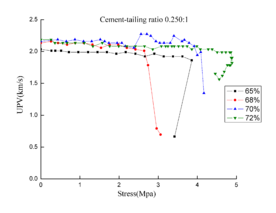
|

|
Fig. 5. Ultrasonic pulse velocity of CPB samples: (a) Ultrasound test results (0.250:1); (b) Ultrasound test results (0.125:1); (c) Ultrasound test results (0.100:1); (d) Ultrasound test results (0.083:1).
3.2 Damage constitutive equations of different backfills
Assuming the CPB is isotropic, according to the Lemaitre theory of strain equivalent [27], we have:
Where σ is the effective stress; E is the elastic modulus; ε is the strain; D is the damage value. When D=0, the backfill is no damage state; when D=1, the backfill is in the course of absolute damage or failure.
Due to the complicated damage mechanism, the morphology and distribution of microscopic defects in the composite materials are random. The strength of the material obeys the Weibull statistical distribution [28].
From the relationship between the damage parameter D and the effective stress σ, it can be seen that the damage parameter D of the CPB also obeys the Weibull statistical distribution. From the Weibull distribution of parameter D, σ, the statistical distribution equation of damage parameters can be obtained:
Where m is Weibull distribution shape parameters, n is the Weibull distribution scale parameters (where m, n 0). Inserting Eq. (3) into Eq. (2):
On the basis of stress-strain curves and considering boundary conditions, we can obtain:
Where εp is the corresponding peak strain when the stress reaches the highest point at σp in the Fig.6.
There are two unknown variables in Eq. (4). By solving Eq. (5), we have:
Combining boundary conditions and inserting Eq. (7) into Eq. (6):
Inserting Eq. (7) and Eq. (8) into Eq. (3):
Eq. (9) is the damage evolution equation of the CPB material under uniaxial compression.
Inserting Eq. (9) into Eq. (2), we can obtain damage constitutive equations of CPB:
According to experiment data and by solving Eq.(9) and Eq.(10),we can obtain the damage constitutive equations of different backfills (Table 3)
According to the stress-strain curves above achieved by experiment, we can obtain the values of the elastic modulus E, the peak stress σp and the peak strain εp By inserting these data into Eq (9) and Eq (10), we can obtain the damage constitutive equations (Table 3) and damage evolutions of different backfills (Table 4). And by calculating with these equations, we can obtain the stress-strain curves of different backfills (dashed lines of Fig.6). Compared with experiment curves ,the calculated results agree well with experiment data.
| Cement-tailing ratio | Elastic modulus
E/Mpa |
Damage constitutive equation | The range of ε |
| 0.250:1 | 471.38 | 471.38(ε-0.0100) exp[-0.178((ε-0.0100)/0.0148)5.56]+1.26 | ε≤0.0248 |
| 471.38ε exp[-0.502 (ε/0.0248)1.99] | ε>0.0248 | ||
| 0.125:1 | 180.15 | 180.15(ε-0.0028) exp[-0.543(ε-0.0028)/0.0205)1.84] | |
| 0.100:1 | 111.66 | 111.66(ε-0.0059) exp[-0.280((ε-0.0059)/0.0191)3.57] | ε≤0.0250 |
| 111.66ε exp[-0.549(ε/0.0250)1.82] | ε>0.0250 |
3.3 Damage laws of different backfills
It is manifest in Table 4 that damage peak values (Dp) of different backfills range from 0.395 to 0.422, and it increases with the increase of cement-tailing ratio.
| Cement-tailing ratio | Elastic modulus
E/Mpa |
Damage evolution equation
D= |
Damage peak value Dp |
| 0.250:1 | 471.38 | 1- exp[-0.50205(ε/0.0248)1.99182] | 0.395 |
| 0.125:1 | 180.15 | 1- exp[-0.54257(ε/0.0205)1.84308] | 0.419 |
| 0.100:1 | 111.66 | 1- exp[-0.27998(ε/0.0191)3.57166] | 0.422 |
According to the damage evolution equations of different backfills, we can obtain the relationship between damage value and strain (shown in Fig.7). It can be observed from Fig.7 that the damage values grow gently with the increase of strain. To be more precise, the larger the cement-tailing ratio is, the more slightly the damage value increases. While after peak stress, the damage values go up steeply with the increase of strain, and the damage peak values get large with decreasing the ratio.
4. Conclusions
In this study, the effects of mass fraction and cement-tailing ratios on the mechanical performance and ultrasonic properties of CPB samples are investigated. A total of 144 CPB samples (70.7 70.7 70.7mm) prepared at different mass fraction and cement-tailing ratio were subjected to the UPV and UCS tests at 7,14 and 28 days of curing times. Based on the experimental results, the following conclusions can be drawn:
(1) The USC values increased with the mass fraction and cement-tailing ratio as well as the extension of curing time. Increasing contents of cementitious materials produce hydration products which in turn improve the USC values of CPB.
(2) The evolution of UPV in CPB is similar with the development of the crack in CPB during loading stress. When the stress stands at its peak, the UPV values drop rapidly. Furthermore, the ultrasonic properties of CPB samples were consistent with their respective USC properties.
(3) There are different mechanical characteristics and damage laws in different backfills. Exactly, the larger the cement-tailing ratio is, the more slightly the damage value increases before the peak stress. The damage grows faster and breakage appears more suddenly after peak stress.
(4) Considering the difficulties of taking core samples from in situ CPB stopes for the determination of CPB strength with conventional compressive strength test, UPV test will allow mine operators/ owners for the rapid estimation of their in situ CPB characteristics.
Declarations
Author contribution statement
Bingwen Wang, Jian Liu: Analyzed and interpreted the data; Wrote the paper.
Lin Li, Yao Yu, Benyong Huo: Conceived and designed the analysis; Analyzed and interpreted the data; Contributed analysis tools or data.
Jie Liu: Contributed analysis tools or data.
Funding
This work was supported by National Key Research & Development Project of China [grant number 2018YFC0808403].
Competing interest statement
The authors declare no conflict of interest.
Additional information
No additional information is available for this paper.
Acknowledgement
The writers are thankful to the reviewers and the editor for their valuable suggestions to improve
the quality of the manuscript.
References
[1] T.Grice, Underground mining with backfill, Australian mining consultants, in the 2nd Annual Summit-Mine Tailing Disposal Systems,Brisbane,Australia,pp.24-25,1998.
[2] M.Fall, J.C.Celestin, M.Pokharel, M.Toure. A contribution to understanding the effects of curing temperature on the mechanical properties of mine cemented tailings backfill. Eng.Geol,114:397-413, 2010.
[3] Mchaina, D.M.Januszewski, S.Hallam, R.L. Development of an environmental impct and mitigation assessment program for a tailings storage facility stability upgrade. International Journal of Surface Min.Recla Environ, 15: 123-140, 2001.
[4] Meggyes, T.Niederlethinger, E.Witt, K.J. Enhancing the safety of tailings management facilities. Soil and Sediment Contamination, 17: 323-345, 2008.
[5] Friedrich, L.Halden, N.M. Determining exposure history of northern pike and walleye to tailings effluence using trace metal uptake in otoliths. Environ Sci Tech,44: 1551-1558, 2010.
[6] Yilmaz E, Benzaazoua M, Belem T. Effect of curing under pressure on compressive strength development of cemented paste backfill. Miner Eng, 22: 772-785,2009.
[7] Yilmaz E., Belem T., BenzaazouaM. Effects of curing and stress conditions on hydromechanical, geotechnical and geochemical properties of cemented paste backfill. Eng Geol, 168: 23-37, 2014.
[8] Yilmaz E., Belem T., Benzaazoua M. Specimen size effect on strength behavior of cemented paste backfills subjected to different placement conditions. Eng Geol, 185: 52-62, 2015.
[9] Yilmaz E, Fall M. Paste tailings management. Canada: Springer International, p. 103-110, 2017.
[10] Benzaazoua M, Fall M, Belem T. A contribution to understanding the hardening process of cemented pastefill. Miner Eng, 17: 141-152, 2004.
[11] Fall M, Célestin JC, Pokharel M, et al. A contribution to understanding the effects of curing temperature on the mechanical properties of mine cemented tailings backfill. Eng Geol, 114: 397-413, 2010.
[12] Karakuş A, Akatay M. Determination of basic physical and mechanical properties of basaltic rocks from P-wave velocity. Nondestr Test Eval, 28: 342-353, 2013.
[13] Sharma PK, Singh TN. A correlation between P-wave velocity, impact strength index, slake durability index and uniaxial compressive strength. Bull Eng Geol Environ, 67: 17-22, 2008.
[14] Kahraman S, Yeken T. Determination of physical properties of carbonate rocks from P-wave velocity. Bull Eng Geol Environ, 67: 277-281, 2008.
[15] Yagiz S. P-wave velocity test for assessment of geotechnical properties of some rock materials. Bull Mater Sci, 34: 947-953, 2011.
[16] Wang Y, Li X. Experimental study on cracking damage characteristics of a soil and rock mixture by UPV testing. Bull. Eng. Geol. Environ, 74: 775-788, 2015.
[17] Meglis IL, Chow T, Martin CD, et al. Assessing in situ microcrack damage using ultrasonic velocity tomography. Int. J. Rock Mech. Min. Sci, 42: 25-34,2005.
[18] M.Diezed’Aux. Ultrasonic Wave Measurement through Cemented Paste Backfill [MSc],Unive-Rsity of Toronto, Canada, 2008.
[19] A.M.Galaa, B.D.Thompson, M.W.Grabinsky, W.F.Bawden. Characterizing stiffness development in hydrating mine backfill using ultrasonic wave measurements, Can. Geotech.J,48: 1174-1187, 2011.
[20] T.Yilmaz, B.Ercikdi, K.Karaman, G.Kulekci, Assessment of strength properties of cemented paste backfill by ultrasonic pulse velocity test, Ultrasonics 54: 1386-1394, 2014.
[21] ASTM C 109–02, Standard test method for compressive strength of hydraulic cement mortars, in: Annual Book of ASTM Standards, American Society of Testing Material, 2003.
[22] ASTM C 597, Standard test method for pulse velocity through concrete, in Annual Book of ASTM Standards, American Society of Testing Material, 2009.
[23] M. Pokharel, M. Fall, Combined influence of sulphate and temperature on thesaturated hydraulic conductivity of hardened cemented paste backfill, Cem.Concr.Compos. 38: 21-28, 2013.
[24] K. Klein, D. Simon, Effect of specimen composition on the strength development in cemented paste backfill, Can. Geotech. J, 43: 310-324, 2006.
[25] B. Ercikdi, A. Kesimal, F. Cihangir, H. Deveci, I. Alp, Cemented paste backfill of sulphide-rich tailings: Importance of binder type and dosage, Cem. Concr.Compos, 31: 268-274, 2009.
[26] S. Kahraman, The correlations between the saturated and dry P-wave velocity of rocks, Ultrasonics, 46: 341-348, 2007.
[27] LEMAITRE J. A course on damage mechanics[M]. Berlin: Springer, 1996.
[28] Ilhan Usta. An innovative estimation method regarding Weibull parameters for wind energy applications. Energy, 68: 301-314, 2016.
Document information
Published on 29/04/21
Accepted on 25/04/21
Submitted on 29/04/20
Volume 37, Issue 2, 2021
DOI: 10.23967/j.rimni.2021.04.006
Licence: CC BY-NC-SA license
Share this document
Keywords
claim authorship
Are you one of the authors of this document?



